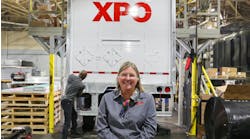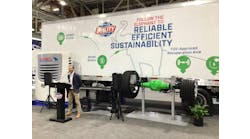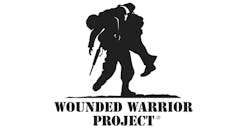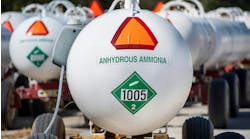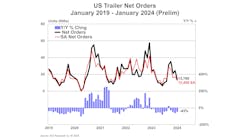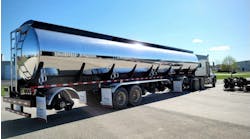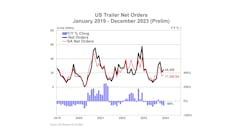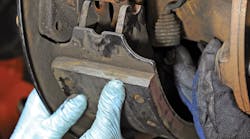WHEN replacing friction material with an aftermarket component that isn't supplied by a brake's original equipment manufacturer (OEM), fleets and drivers run the risk of falling out of compliance with federally mandated Reduced Stopping Distance (RSD) requirements, according to Gary Ganaway, director of marketing and global customer solutions for Bendix Spicer Foundation Brake.
He said that because OEMs engineer their brakes and friction material to work together, introducing an outside manufacturer's friction to a braking system can have short- and long-term effects on brake performance and vehicle safety.
“I think the most important point is the fact that whether we're talking about trailers or power units, aftermarket parts are not governed or protected,” he said. “They do not have to adhere to the same performance criteria as original equipment. With that in mind, many of our end users and fleet customers make the mistake of buying on price alone. The compromise on that becomes the potential degradation in performance and degradation in wear, so the actual cost of ownership could be higher due to things like wear and rust-jacking, which are more prone, we've seen, in lower-cost linings.
“The first thing we encourage people to do is try to find out what material specification the vehicle or trailer was built with originally. There's always a significant amount of engineering effort that goes into spec'ing. The material that typically comes on the vehicle takes into consideration the total cost of ownership, wear, and performance. We find typically as long as the end user stays with that material, the results are very consistent with the new equipment.
“We've seen a lot more of low-cost offshore suppliers now. Typically what happens is that different friction materials look very similar. You really need a dynamometer or a vehicle test to evaluate them. Typically a fleet or end user purchases on price. Due to the nature of the trailer — it's difficult to track mileage — he then unknowingly runs into problems. Add those costs up, and the cheaper lining may actually be more expensive.
“We've seen an increased number of offshore suppliers typically sold on private and very familiar North American brand names, but what I'd characterize as questionable in origin.”
Reduced stopping distances
Ganaway said federally mandated reduced stopping distance regulations pertain to power units only, and specifically tractors.
“Trailers are not bound by RSD per se, but they are bound by dynamometer performance requirements, which also are covered by FMVSS 121,” he said. “Each of the trailer manufacturers in the US adheres to that standard. The thinking is that the integrity of the brakes on the trailer must be of a certain level since they work in tandem with tractor brakes that are covered by FMVSS 121 on the new stopping distance requirements.
So why were trailer brakes not included in this recent change to FMVSS 121?
“Think about what's happening from a vehicle-dynamics standpoint as the combined unit makes a braking application,” Ganaway says. “The loads shift toward the front and effectively the rear-most wheels are unloaded. For that reason, there was not a lot of benefit in increasing the requirements for the trailer brake. Trailer brakes didn't really need to change that much.”
While the new reduced stopping distance requirements do not directly apply to trailer brakes, chemistry does. Deicing chemicals are having a major effect on trailer brakes.
“We see a lot of complaints about rust-jacking, so we put a lot of engineering effort into our paint process,” Ganaway says.
Corrosion protection should be a key consideration when buying (or selling) brake shoes, Ganaway says.
